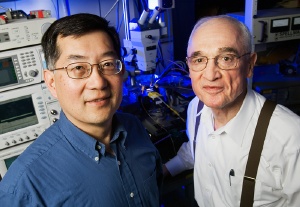Jun 16 2009
Researchers have constructed a light-emitting transistor that has set a new record with a signal-processing modulation speed of 4.3 gigahertz, breaking the previous record of 1.7 gigahertz held by a light-emitting diode.
 Milton Feng and Nick Holonyak have constructed a light-emitting transistor that has set a new record with a signal-processing modulation speed of 4.3 gigahertz. | Photo by L. Brian Stauffer
Milton Feng and Nick Holonyak have constructed a light-emitting transistor that has set a new record with a signal-processing modulation speed of 4.3 gigahertz. | Photo by L. Brian Stauffer
But, the researchers didn't stop there. By internally connecting the base and collector of a light-emitting transistor, they created a new form of light-emitting diode, which modulates at up to 7 gigahertz, breaking the speed record once again.
In a pair of papers published in the June 15 issue of Applied Physics Letters, researchers at the University of Illinois and at U. of I. licensee Quantum Electro Opto Systems in Melaka, Malaysia, report the fabrication and testing of the new high-speed light-emitting transistor and the new "tilted-charge" light-emitting diode.
"Simple in design and construction, the tilted-charge light-emitting diode offers an attractive alternative for use in high-speed signal processing, optical communication systems and integrated optoelectronics," said Nick Holonyak Jr., a John Bardeen Chair Professor of Electrical and Computer Engineering and Physics at Illinois, and a co-author of both papers.
The modulation speed of either a light-emitting diode or a light-emitting transistor is limited by the rate at which electrons and holes (the minus and plus charges - the carriers of current) recombine. The recombination lifetime is important in determining device speed.
With a usual "slow" recombination process, the speed of a light-emitting diode is limited to approximately 1.7 gigahertz, which corresponds to a carrier lifetime of 100 picoseconds. For more than 40 years, scientists thought breaking the 100-picosecond barrier was impossible.
Recombination speeds of less than 100 picoseconds are not readily achieved in light-emitting diodes because equal number densities of electrons and holes are injected into the active region to preserve charge neutrality, said Holonyak, who invented the first practical visible light-emitting diode more than 40 years ago.
These charges become stuck, stacked-up waiting to recombine, Holonyak said. To achieve high recombination speeds, an extremely high injection level and a very high charge population are required in light-emitting diodes. These conditions are not necessary in transistors, however.
"Unlike a diode, a transistor does not store charge," said Milton Feng, the Holonyak Chair Professor of Electrical and Computer Engineering, and a co-author of the two papers. "Charges are delivered to the transistor's quantum well active region, where they either recombine almost instantly, or they are kept moving on out of the device. The charges do not become stacked-up, waiting to recombine with their oppositely charged twins."
To increase the modulation speed of their light-emitting transistor, the researchers reduced the emitter size, increased the so-called collector thickness (the third terminal region), and utilized a special internal common collector design. These changes resulted in a faster signal at a very low current level, and at low heat dissipation.
Having a "fast" recombination process, the modulation speed of the light-emitting transistor was measured at 4.3 gigahertz, which corresponds to a recombination lifetime of 37 picoseconds, well under the "100-picosecond barrier."
"In the light-emitting transistor, the third terminal - the collector - effectively 'tilts' the charge and removes carriers with slower recombination lifetimes," said Holonyak, who also is a professor in the university's Center for Advanced Study, one of the highest forms of campus recognition.
"As opposed to the charge 'pile-up' condition found in a normal diode, the dynamic 'tilted' charge flow condition in the transistor base is maintained with the collector in competition with the base recombination process," Holonyak said. "If the charge doesn't recombine and generate a photon fast enough, it is swept away by the current in the collector."
By preventing the build-up of "slow" charges in the base, the "fast" picosecond recombination dynamics also provided the basis for the researchers' light-emitting transistor rewired internally as a new type of light-emitting diode.
The tilted-charge light-emitting diode achieved a record-breaking modulation speed of 7 gigahertz, corresponding to a recombination lifetime of 23 picoseconds.
"The tilted-charge light-emitting diode is simple to make, low cost, and easy to package and use," Holonyak said.
Because of the tilted base population in the device, current flow, which is a function of the slope of the charge distribution, makes possible high current densities without requiring extreme carrier densities.
"That's the trick of the transistor," Holonyak said. "And now we've incorporated it into a diode. The physics has been there all along. It just wasn't recognized."